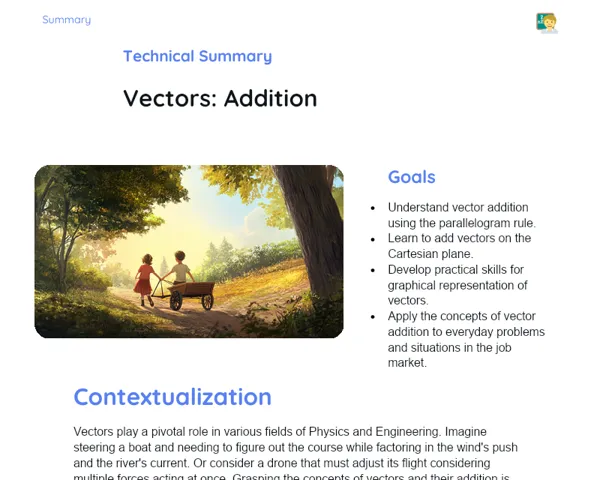Summary Tradisional | Simple Harmonic Motion: Mass-Spring System
Contextualization
Simple Harmonic Motion (SHM) refers to a specific type of periodic motion where a restoring force is directly proportional to the distance from the equilibrium position. This fundamental concept is key to grasping a range of physical phenomena, often illustrated through the mass-spring system, where a mass attached to a spring oscillates around a central point. In SHM, the restoring force is defined by Hooke's Law, which is mathematically expressed as F = -kx, with F representing the restoring force, k the spring constant, and x the deviation from the equilibrium position.
Having a solid understanding of SHM is vital for tackling both practical and theoretical challenges in physics. For instance, vehicle suspension systems take advantage of SHM principles to manage shocks and ensure a smoother ride. SHM also plays a critical role in pendulum clocks, where the pendulum's consistent period allows for accurate timekeeping. Mastering these concepts empowers students to apply SHM knowledge in a variety of real-world and technological scenarios.
To Remember!
Definition of Simple Harmonic Motion (SHM)
Simple Harmonic Motion (SHM) occurs when a restoring force is directly proportional to the displacement from an equilibrium state. This motion follows Hooke's Law, which can be articulated through the formula F = -kx, where F is the restoring force, k is the spring constant, and x is the displacement from the equilibrium. In SHM, this restoring force always works to bring the system back to equilibrium.
In the case of a mass-spring setup, when the mass is displaced and released, it begins to oscillate around that point driven by the spring's restorative force. This motion is periodic, meaning it repeats consistently over time. The periodic nature of SHM allows us to define important measures such as time period, frequency, and amplitude, all of which are essential for a comprehensive understanding of the motion.
SHM is a core principle in physics as it provides an idealized framework for many real-world systems that display oscillatory motion. Examples extend beyond the mass-spring system to include simple pendulums, molecular vibrations, and electric currents in AC circuits. Exploring SHM establishes a robust foundation for solving problems across various physics and engineering domains.
-
SHM features a restoring force that is proportional to the displacement.
-
Hooke's Law (F = -kx) outlines the behavior of the restoring force in SHM.
-
SHM signifies a periodic motion that recurs at consistent time intervals.
Amplitude (A)
In Simple Harmonic Motion (SHM), amplitude is defined as the farthest distance the mass moves away from its equilibrium position. In simpler terms, it is the maximum displacement the mass achieves during its oscillation. Amplitude indicates the system's total energy and remains constant in an ideal SHM scenario where there is no damping.
The amplitude is crucial as it directly affects the maximum velocity and acceleration accessible to the mass. A higher amplitude results in greater potential energy stored in the spring, thereby leading to increased kinetic energy when the mass crosses through the equilibrium position. The correlation between amplitude and energy can be represented with the potential energy formula at maximum extension: E_pot = ½kA².
Grasping amplitude is vital for resolving SHM-related problems as it directly impacts other movement aspects like velocity and acceleration. Moreover, amplitude can be affected by external forces or damping, which modify the system's total energy.
-
Amplitude denotes the maximum displacement of the mass from its equilibrium point.
-
It serves as a measure of the system's total energy and is consistent in an ideal SHM.
-
The connection between amplitude and potential energy is defined through E_pot = ½kA².
Period (T) and Frequency (f)
The period (T) of Simple Harmonic Motion (SHM) defines the time required for the mass to complete a single full oscillation, returning to its original position with identical velocity and direction. The period for a mass-spring system can be calculated using T = 2π√(m/k), where m is the mass and k represents the spring constant. The period is a key characteristic of SHM, indicating how rapidly the system oscillates.
Frequency (f) refers to the count of full oscillations that take place per time unit, typically measured in hertz (Hz). There exists an inverse relationship between period and frequency, articulated by f = 1/T. Thus, once we have the period of a mass-spring system, we can easily derive the frequency and vice versa. Understanding frequency is important as it signifies the rate at which the system oscillates.
Familiarity with the concepts of period and frequency is crucial for analyzing and solving SHM-related issues. These measurements are vital for describing oscillatory motions in various sectors, including mechanical engineering, acoustics, and electromagnetism. Furthermore, having knowledge of period and frequency is essential for designing devices dependent on periodic motions, like clocks and suspension systems.
-
The period measures the time required for one complete oscillation and is calculated using T = 2π√(m/k).
-
Frequency indicates the number of oscillations per time unit and is given by f = 1/T.
-
There is an inverse relationship between period and frequency.
Velocity (v) and Acceleration (a)
In Simple Harmonic Motion (SHM), the velocity and acceleration fluctuate based on time and the mass's position. Maximum velocity is attained when the mass reaches the equilibrium position, where the potential energy fully converts to kinetic energy. The velocity at any given point is described by the formula v = Aωcos(ωt + φ), where A represents amplitude, ω is the angular frequency, and φ is the initial phase.
Maximum acceleration occurs at maximum displacement points, where the restoring force is at its peak. The formula for acceleration at any point is a = -Aω²sin(ωt + φ). Acceleration correlates to displacement and continually aims to return the mass to the equilibrium position. The angular frequency (ω) is connected to frequency and period through the equation ω = 2πf.
Understanding how velocity and acceleration in SHM change is critical for solving dynamic problems linked to mass-spring setups. These factors are vital for comprehending how energy is exchanged between kinetic and potential forms during the motion. Additionally, analyzing velocity and acceleration variations aids in forecasting the system's conduct at distinct points along its path.
-
The maximum velocity occurs at the equilibrium position, calculated as v = Aωcos(ωt + φ).
-
Maximum acceleration takes place at maximum displacement, given by a = -Aω²sin(ωt + φ).
-
Velocity and acceleration change with time and the mass's position in SHM.
Key Terms
-
Simple Harmonic Motion (SHM): A periodic motion defined by a restoring force that is proportional to the displacement.
-
Amplitude (A): The maximum displacement of the mass from the equilibrium position.
-
Period (T): Time taken for one complete oscillation.
-
Frequency (f): The number of oscillations made per unit of time.
-
Angular Frequency (ω): The rate of oscillation in radians per second, connected to period and frequency.
-
Restoring Force: The force acting to bring the mass back to the equilibrium point, defined as F = -kx.
-
Kinetic Energy (E_cin): The energy linked with the motion of the mass, calculated with E_cin = ½mv².
-
Potential Energy (E_pot): The energy stored in the mass-spring system, calculated by E_pot = ½kx².
Important Conclusions
Simple Harmonic Motion (SHM) is a fundamental principle in physics that illustrates the periodic motion of systems where a restoring force correlates to the displacement from the equilibrium position. In this lesson, we examined how the mass-spring system exemplifies this motion, emphasizing the importance of Hooke's Law and the connection between restoring force and displacement.
We covered vital parameters characterizing SHM, including amplitude, period, frequency, velocity, and acceleration. Familiarity with these metrics is essential for analyzing and solving both practical and theoretical challenges, facilitating SHM applications in diverse contexts ranging from vehicle suspension systems to pendulum clocks.
To conclude, we explored the various energies present in SHM, such as kinetic and potential energy, and how these energies convert during motion. Understanding these energy transformations is crucial for predicting the behavior of oscillating systems and leveraging this knowledge in technology and observable physical phenomena in our daily lives.
Study Tips
-
Revise the formulas and concepts discussed, especially the mathematical relationships involving restoring force, amplitude, period, and frequency.
-
Practice calculating with examples of mass-spring systems. This practice will solidify your comprehension of the calculations related to SHM.
-
Look for additional resources like educational videos and interactive simulations that illustrate Simple Harmonic Motion in action. These can enrich your understanding of the concepts.



